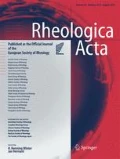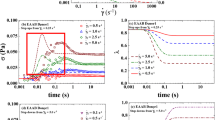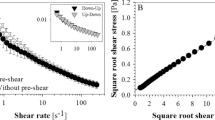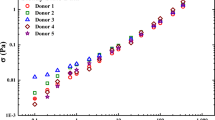Abstract
Despite being at the same time a very common and precious fluid, the rheological properties of blood have not been thoroughly investigated. In this manuscript, the rheology of swine blood is characterized. The rheology study is performed in shear flow and in uniaxial elongation. Measurements show that blood is a shear-thinning and viscoelastic fluid. The relaxation time and elongational viscosity of blood are measured. The relaxation time is found in agreement with a recent measurement by Brust et al. (2013). It is shown for the first time that the elongational viscosity can be 1000 times higher than the shear viscosity. Implications in biology and forensics are described.






Similar content being viewed by others
References
Allain C, Limat L (1995) Regular patterns of cracks formed by directional drying of a colloidal suspension. Phys Rev Lett 74(15):2981–2984
Apostolidis A, Beris AN (2014) Modeling of the blood rheology in steady-state shear flows. J Rheology 58(3):607–633
Attinger D, Haferl S, Zhao Z, Poulikakos D (2000) Transport phenomena in the impact of a molten droplet on a surface: macroscopic phenomenology and microscopic considerations. Part II: heat transfer and solidification. Ann Rev Heat Transfer 11(11):65–143
Attinger D, Moore C, Donaldson A, Jafari A, Stone HA (2013) Fluid dynamics topics in bloodstain pattern analysis: comparative review and research opportunities. Forensic Sci Int 231(1):375–396
Bartolo D, Bouamrirene F, Verneuil E, Buguin A, Silberzan P, Moulinet S (2006) Bouncing or sticky droplets: impalement transitions on superhydrophobic micropatterned surfaces. Europhys Lett 74(2):299–305
Behrooz N, Hulse-Smith L, Chandra S (2011) An evaluation of the underlying mechanisms of bloodstain pattern analysis error. J Forensic Sci 56(5):1136–1142
Bertola V (2009) An experimental study of bouncing Leidenfrost drops: comparison between Newtonian and viscoelastic liquids. Int J Heat Mass Transf 52(7):1786–1793
Bevel T, Gardner RM (2008) Bloodstain pattern analysis with an introduction to crime scene reconstruction. CRC Press, Boca Raton, FL, USA
Brust M, Schaefer C, Doerr R, Pan L, Garcia M, Arratia P, Wagner C (2013) Rheology of human blood plasma: viscoelastic versus Newtonian behavior. Phys Rev Lett 110(7):078305
Carre A, Gastel JC, Shanahan MER (1996) Viscoelastic effects in the spreading of liquids. Nature 379(6564):432–434
Caviezel D, Narayanan C, Lakehal D (2008) Adherence and bouncing of liquid droplets impacting on dry surfaces. Microfluid Nanofluid 5(4):469–478
Chandrasekhar S (1981) Hydrodynamic and hydromagnetic stability. Dover Publ, New York
Charm S, Kurland G (1965) Viscometry of human blood for shear rates of 0–100,000 sec−1. Nature 206(4984):617–618
Chen L, Li Z (2010) Bouncing droplets on nonsuperhydrophobic surfaces. Phys Rev E 82(1):016308
Chien S, King RG, Skalak R, Usami R, Copley AL (1975) Viscoelastic properties of human blood and red-cell suspensions. Biorheology 12(6):341–346
Clasen C, Bico J, Entov VM, McKinley GH (2009) ‘Gobbling drops’: the jetting-dripping transition in flows of polymer solutions. J Fluid Mech 636:5–40
Cooper-White JJ, Crooks RC, Boger DV (2002) A drop impact study of worm-like viscoelastic surfactant solutions. Colloids Surfaces A 210(1):105–123
Copley AL, King RG, Chien S, Usami S, Skalak R, Huang CR (1975) Microscopic observations of viscoelasticity of human blood in steady and oscillatory shear. Biorheology 12(6):257–263
De Gennes PG (1974) Coil-stretch transition of dilute flexible polymers under ultrahigh velocity gradients. J Chem Phys 60(12):5030–5042
Eggers J, Villermaux E (2008) Physics of liquid jets. Rep Prog Phys 71(3):036601
Fahraeus R, Lindqvist T (1931) The viscosity of the blood in narrow capillary tubes. Am J Physiol 96(3):562–568
Gruttola SD, Boomsma K, Poulikakos D (2005) Computational simulation of a non-Newtonian model of the blood separation process. Artif Organs 29(12):949–959
Hoyt JW, Taylor JJ (1977) Turbulence structure in a water jet discharging in air. Phys Fluids 20(10):S253–S257
Huang CR, Chen HQ, Pan WD, Shih T, Kristol DS, Copley AL (1987) Effects of hematocrit on thixotropic properties of human blood. Biorheology 24(6):803–810
Hung TC, Hochmuth RM, Joist JH, Sutera SP (1976) Shear-induced aggregation and lysis of platelets. ASAIO J 22(1):285–290
Jiang T, Jie O, Yang B, Ren J (2010) The SPH method for simulating a viscoelastic drop impact and spreading on an inclined plate. Comput Mech 45(6):573–583
Johnston BM, Johnston PR, Corney S, Kilpatrick D (2004) Non-Newtonian blood flow in human right coronary arteries: steady state simulations. J Biomech 37(5):709–720
Joseph DD, Belanger J, Beavers GS (1999) Break up of a liquid drop suddenly exposed to a high-speed airstream. Int J Multiphase Flow 25(6):1263–1303
Laber TL, Epstein BP, Taylor MC (2008) High speed digital video analysis of bloodstain pattern formation from common bloodletting mechanisms. IABPA News 24(2):4–12
Leuprecht A, Perktold K (2001) Computer simulation of non-Newtonian effects on blood flow in large arteries. Computer Methods in Biomechanics and Biomedical Engineering 4:149–163
Lin SP, Reitz RD (1998) Drop and spray formation from a liquid jet. Annu Rev Fluid Mech 30(1):85–105
Meiselman HJ, Neu B, Rampling MW, Baskurt OK (2007) RBC aggregation: laboratory data and models. Indian J Exp Biol 45:9–17
Merrill EW (1969) Rheology of blood. Physiol Rev 49(4):863–888
Mighri F, Carreau PJ, Ajji A (1998) Influence of elastic properties on drop deformation and breakup in shear flow. J Rheol 42(6):1477–1490
Morshed KN, Bark D Jr, Forleo M, Dasi LP (2014) Theory to predict shear stress on cells in turbulent blood flow. PLoS One 9(8):e105357
National Research Council USA (2009) Strengthening forensic science in the United States: a path forward. Committee on Identifying the Needs of the Forensic Sciences Community. The National Academies Press, Washington, DC. 177–179. doi:10.17226/12589
Poole RJ, Ridley BS (2007) Development-length requirements for fully developed laminar pipe flow of inelastic non-Newtonian liquids. J Fluids Eng 129(10):1281–1287
Ramstack JM, Zuckerman L, Mockros LF (1979) Shear-induced activation of platelets. JBiomech 12(2):113–125
Rein M (1993) Phenomena of liquid drop impact on solid and liquid surfaces. Fluid Dyn Res 12:61–93
Reneker DH, Yarin AL, Zussman E, Xu H (2007) Electrospinning of nanofibers from polymer solutions and melts. Adv App Mech 41:43–195
Sinha-Ray S, Srikar R, Lee CC, Li A, Yarin AL (2011) Shear and elongational rheology of gypsum slurries. App Rheol 21(6):63071
Steffe JF (1996) Rheological methods in food process engineering. Freeman Press, USA
Thoroddsen ST, Etoh TG, Takehara K (2008) High-speed imaging of drops and bubbles. Annu Rev Fluid Mech 40:257–285
Tiwari MK, Bazilevsky AV, Yarin AL, Megaridis CM (2009) Elongational and shear rheology of carbon nanotube suspensions. Rheol Acta 48(6):597–609
Tropea C, Yarin AL, Foss JF (Eds) (2007) Springer handbook of experimental fluid mechanics. Springer, Heidelberg
Walker H, Hall W, Hurst J (1990) Clinical methods: the history, physical, and laboratory examinations, 3rd edn. Butterworths, Boston
Wickham LL, Bauersachs RM, Wenby RB, Sowemimo-Coker S, Meiselman HJ, Elsner R (1990) Red cell aggregation and viscoelasticity of blood from seals, swine and man. Biorheology 27(2):191–204
Williams E, Taylor M (2013) Standardising blood physical properties: implications for precision bloodstain pattern analysis research. IABPA (International Association of Bloodstain Pattern Analysts) Training Conference, San Diego, CA
Windberger U, Bartholovitsch A, Plasenzotti R, Korak KJ, Heinze G (2003) Whole blood viscosity, plasma viscosity and erythrocyte aggregation in nine mammalian species: reference values and comparison of data. Exp Physiol 88(3):431–440
Wurzinger LJ, Opitz R, Blasaberg L, Schmid-Schonbein M (1985) Platelet and coagulation parameters following millisecond exposure to laminar shear stress. Thromb Haemost 54(2):381–386
Yarin AL (1993) Free liquid jets and films: hydrodynamics and rheology. Harlow, New York, Longman Scientific & Technical and John Wiley & Sons
Yarin AL (2006) Drop impact dynamics: splashing, spreading, receding, bouncing. Annu Rev Fluid Mech 38(1):159–192
Yarin AL, Pourdeyhimi B, Ramakrishna S (2014) Fundamentals and applications of micro- and nanofibers. Cambridge University Press, Cambridge
Yilmaz P, Gundogdu MY (2008) A critical review on blood flow in large arteries; relevance to blood rheology, viscosity models, and physiological conditions. Korea-Australia Rheol J 20(4):197–211
Yue P, Zhou C, Feng JJ, Ollivier-Gooch CF, Hu HH (2006) Phase-field simulations of interfacial dynamics in viscoelastic fluids using finite elements with adaptive meshing. J Comput Phys 219(1):47–67
Acknowledgments
The authors acknowledge financial support from the US National Institute of Justice (award NIJ 2014-DN-BX-K036).
Author information
Authors and Affiliations
Corresponding authors
Rights and permissions
About this article
Cite this article
Kolbasov, A., Comiskey, P.M., Sahu, R.P. et al. Blood rheology in shear and uniaxial elongation. Rheol Acta 55, 901–908 (2016). https://doi.org/10.1007/s00397-016-0964-1
Received:
Revised:
Accepted:
Published:
Issue Date:
DOI: https://doi.org/10.1007/s00397-016-0964-1




